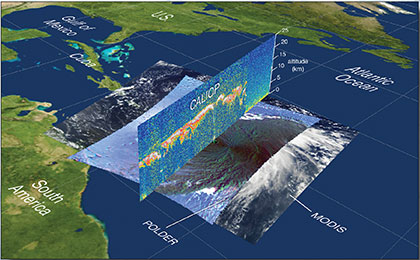
An image of Hurricane Bill as seen from the MODIS instrument (flying on Aqua) with cloud heights from the CALIOP lidar (on CALIPSO) on August 19, 2009. Superimposed over the MODIS image is the polarized reflected sunlight observed by POLDER (on PARASOL).
Having examined the roles of the individual components of the Afternoon Constellation, let’s now consider the value of the entire formation. By combining all of these components in a carefully engineered formation, scientists are able to gain a better understanding of important parameters related to climate change.
The A-Train and C-Train formations allow for synergistic measurements—meaning that data from several different satellites can be used together to obtain comprehensive information about various key atmospheric components or processes. Combining the information from several sources gives a more complete answer to many questions than would be possible from any single satellite taken by itself. Some of the most important questions are listed below followed by information on how the information obtained by the satellites of the Afternoon Constellation can be combined together to help scientists answer these questions.